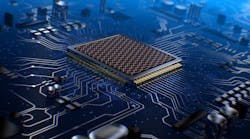The computer chip learned to recognize four basic vowel sounds, and it guessed correctly three out of every four times when tested. Other processors are more accurate – correct around 90% of the time – but few are as unique.
On Monday, researchers at the Massachusetts Institute of Technology revealed the new chip, called a nanophotonic processor, which uses light instead of electricity to solve the unforgiving math at the heart of machine learning. Using microscopic lenses instead of transistors, it could vastly improve algorithms that learn to make decisions in smartphones to sensors.
The ten researchers, writing in the journal Nature Photonics, said that the experimental chip could be carefully tuned to control light and solve so-called matrix multiplications much faster and more efficiently than traditional computer chips. The idea is that light moves much faster than the electrons cascading through transistors.
These calculations are vital to deep learning algorithms, which mimic how the brain learns from an accumulation of examples to improve voice recognition, image classification, or autonomous driving software. But these multiplication tables not only take the most time but also consume the most power, the researchers said.
The optical chip contains multiple waveguides that shoot beams of light at each other simultaneously, creating interference patterns that correspond to mathematical results. The proof-of-concept performs matrix calculations with a thousandth of the power used by traditional chips, the researchers said
"The chip, once you tune it, can carry out matrix multiplication with, in principle, zero energy, instantly," said Marin Soljacic, a professor of electrical engineering that worked on the chip, in a statement. The accuracy leaves something to be desired for making out vowels, but the nanophotonic chip is still far from finished.
Years from now, it could be useful "whenever you need to do a lot of computation but you don't have a lot of power or time," said Nicholas Harris, an author of the paper in Nature Photonics, in a statement. It could also improve signal processing because light, which is analog, would not have to be converted into a digital signal.
The nanophotonic chip is still not a complete system. Soljacic said that further advances would only be possible with more time and investment. "We've demonstrated the crucial building blocks but not yet the full system," he said in a statement, not giving a timeline for its completion.
Other platforms have targeted matrix multiplications, which help strengthen links between the virtual neurons in deep learning software. The Volta graphics chip released by Nvidia last month, for instance, contain specialized "tensor cores" that runs matrix multiplications in parallel and then multiplies those results in parallel again to do faster training and inferencing than other chips.
